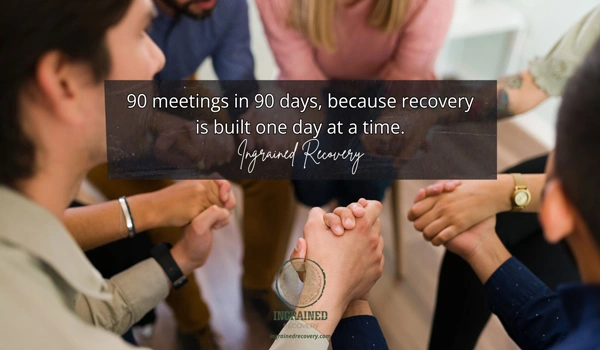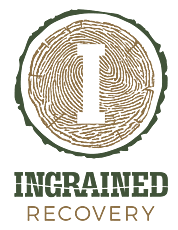90 Meetings in 90 Days: Building a Solid Path to Lasting Sobriety
The reason some people in Alcoholics Anonymous or Narcotics Anonymous are sometimes committed to 90 meetings in 90 days is simple. Attending meetings daily helps them build a strong support network.
Some experts on recovery insist that substance abuse treatment is actually the easy part; the hard work starts after leaving a program, when the day-to-day challenges of recovery from any addiction hit hardest.
When it comes to finding freedom, detox recovery centers can provide a safe space for a short time. The reality of cravings and emotional struggles can still be pretty intense for several months.
Ingrained Recovery suggests that our program graduates seek programs like Alcoholics Anonymous (AA) and Narcotics Anonymous (NA) to create a support system in their new, sober life.
90 in 90 AA and NA are especially beneficial in the early days of sobriety, when returning to everyday life can honestly feel a bit overwhelming. We encourage you to continue reading to learn how regular attendance in the first 90 days can continue to support your lifelong journey to lasting sobriety.
Get Accredited Treatment Programs at Ingrained Recovery

What Does 90 in 90 AA and NA Really Mean?
Attending 90 meetings in 90 days is a common suggestion for new members. Some offer guidance to do so because attending AA or NA then becomes part of a structured routine during those early days of recovery from addiction. Daily meetings can establish a strong foundation and get the recovery journey off to a great start.
A 1998 study published in the Journal of Substance Abuse Treatment found that participants who decided to stay committed to 90 meetings in 90 days were likelier than peers who attended fewer meetings to continue a healthy life without substances. Since that study, many researchers have tested these findings but have been unable to refute the benefits of 90 meetings in 90 days.
What is the Origin of 90 Meetings in 90 Days for AA and NA Members?
The concept of 90 meetings in 90 days originated in Alcoholics Anonymous (AA), although NA groups and other 12-step recovery programs also suggest it.
Even before the scientific studies, men and women attending AA meetings likely found the meeting format comforting and helpful, usually avoiding relapses. The opportunity to find daily support and develop healthy coping mechanisms offered the men and women attending a lifeline.
Get Proven Detox and Rehab Options at Ingrained

What are the Benefits of Attending 90 Meetings in 90 Days?
Daily meetings help you build, support, and develop experienced individuals in recovery. Besides meeting peers who have found success in 12-step recovery programs like AA or NA, the programs also provide access to sponsors to help you if you ever feel “stuck” in the program.
The program encourages emotional healing to help you avoid future substance use, but the meetings reinforce the key principles of recovery every time you attend.
Why the Power of 90 Meetings Over 90 Days Helps Early Recovery
The power of 90 meetings in 90 days is in its reward – three months of sobriety. Attending daily in-person or virtual meetings creates a strong foundation for sobriety. You now spend the time you would once have spent drinking or using drugs to build a fulfilling, substance-free life.
You’re also associating with a supportive community that contributes to long-term sobriety and avoiding people who can activate the substance use disorder. These benefits make recovery programs like Alcoholics Anonymous and Narcotics Anonymous a powerful tool for long-term recovery.
Staying Committed to 90 Meetings and Daily Accountability
Committing to 90 meetings in 90 days doesn’t merely mean showing up. Instead, it means doing the hard work. You will create daily accountability, knowing others will see you again tomorrow. The regular check-in makes it harder to self-isolate to drink or use. Each time you attend, you make headway in the recovery process.
AA Meetings Provide Structure and Support for Early Rcovery
For those who are attending 90 meetings in 90 days without having completed formal treatment options, the AA recovery community may be the first place they feel heard and understood. Meetings provide a predictable, structured routine that can bring comfort to someone struggling.
The structure and support provided by AA meetings make people in the early days of sobriety feel like they can release their harmful old habits and make changes for the better.
Building a Strong Foundation for Sobriety Through 90 in 90 Attendance

Addiction is a disease that requires more than willpower. Changing old habits requires consistent action every day, with daily meetings being a good starting point.
Your support group is an excellent space where you can safely ask questions, sort through your emotions, and learn from others who are ahead of you in the program. In time, you will find the exact tools to help with staying sober for good.
Putting Together the Components of a Recovery Toolkit
Attending meetings each day forms a lasting foundation for long-term recovery. 90 meetings in 90 days help you replace destructive habits and routines with healing and a path to sobriety.
The skills you master as you complete the steps of your support group build stability that will serve you well in the future. You will also see that you have a reliable support system to turn to, no matter what curveballs life throws at you.
Overcoming Obstacles While Committed to 90 Meetings
As mentioned in the opening paragraph, life after addiction treatment can be fraught with pitfalls. But attending NA and AA meetings can become a North Star that guides you on your recovery journey, no matter what happens.
Some real, everyday obstacles you face can include busy family schedules, the pressure of school or careers, or dealing with specific triggers. Your commitment to 90 meetings in 90 days means finding ways to clear these hurdles regardless of difficulty.
Solidifying Peer Support Connections in Early Sobriety
Some attend one support group in person on certain days and online on others. You might double up and attend two meetings to make up for a missed day.
Or, you may have to take an honest look at your planning skills and reprioritize attending 90 meetings. The effort to make it to 90 meetings in 90 days shows off your resilience and problem-solving skills.
After 90 Days: What's Next After the First Three Months?

What happens after you have attended 90 meetings in 90 days? Your commitment has helped you create a strong foundation of tools and a support system. Some choose to continue daily attendance. Most scale back to a few meetings per week. As the program has shown you, the point is never perfection but progress.
Building a Lasting Foundation Beyond Early Recovery
Meetings reinforce key principles that help you stay sober, so you are well-equipped to continue working on sobriety. You will continue your step work, take on service or leadership roles in your 12-step group, or mentor newcomers.
The recovery process will continue, with the lessons learned while attending 90 meetings remaining your rock-solid foundation.
How 90 in 90 AA and NA Supports Relapse Prevention and Prevents Pink Cloud Thinking
Preventing a relapse in the early days of recovery is probably the best argument for completing a 90 in 90 challenge. Early sobriety is fragile, and you may still have cravings for your drug of choice.
Alternatively, you may feel as though you are on a ‘pink cloud,’ and that nothing will ever disrupt your newfound recovery. But life has a way of challenging this notion, even for the most committed people in the early days of getting clean and sober.
Fortunately, many others have experienced similar thoughts, and the peer support and guidance from those with lived experience is shared when daily meetings offer guidance and support.
Your meetings provide you with daily reminders of what is at stake and how others who struggle have succeeded. Your peers are role models who offer you stability and hope.
As an additional support, we also offer a relapse prevention worksheet resource for our clients, as well as for clinicians and anyone seeking help.
Integrating 90 in 90 With Professional Addiction Treatment
Some people enter the 90 in 90 phase right after leaving residential care, while others use 12-step programs to supplement step-down outpatient treatment. Daily meetings along with professional support is the most comprehensive approach.
Licensed therapists address trauma and underlying mental health needs, while meetings offer peer support and fellowship. This all-encompassing approach can be necessary for people with a dual diagnosis or more severe addictions.
Up To 100% of Rehab Costs Covered By Insurance
Call Ingrained Recovery to Begin Building a Lasting Foundation
Some people find sobriety elusive when they try AA or NA without also getting professional care. That’s okay and more common than you think. If you have found 12-step programs helpful but not quite enough to help you achieve recovery, it’s time to get the help you deserve.
Ingrained Recovery, located in Eastman, Georgia, is available to address all your addiction treatment needs at our 50-acre recovery ranch.
Call our admissions department for details; reaching out to us to learn more is free and confidential, so please call our caring and welcoming staff now.
